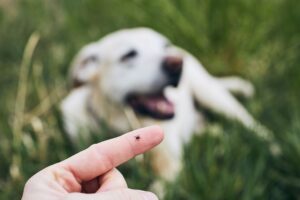
In honor of National Lyme Prevention Month, this article discusses Lyme disease in pets.
Lyme disease is a bacterial infection that often spreads to joints and the kidneys, affecting dogs and people. Although it’s most prevalent in the Northeast, mid-Atlantic, and upper Midwest, the range has increased throughout much of North America. In honor of National Lyme Prevention Month, this article discusses Lyme disease in pets.
Transmission of Lyme Disease
Lyme infection is caused by the bacteria Borrelia burgdorferi, which resides inside a specific type of tick known as black-legged or deer. These are small ticks, and they can range from a poppy seed’s size to a sesame seed. After a tick with the Lyme bacteria attaches to the skin, transmission takes 24 to 48 hours. Prompt removal of ticks may help avoid Lyme infections.
Clinical Signs
Most canines exposed to Lyme will not become visibly sick. However, those that do become ill can have some serious symptoms. Symptoms often don’t occur until 2 to 5 months after a tick bite for those who become sick. The most common signs of Lyme disease in pets include:
- Lameness – can alternate between limbs
- Fever
- Lethargy
- Joint swelling and pain
- Swollen lymph nodes
- Decreased appetite
A less prevalent but severe complication linked with Lyme disease in pets causes kidney damage (Lyme nephritis). The clinical signs of kidney damage are more severe than the typical Lyme infection, which includes not eating, weight loss, vomiting, increased thirst and urination, extreme lethargy, and more.
Diagnosis
A vet can diagnose Lyme disease in pets based on the typical clinical signs combined with an inexpensive and quick blood exam determining the absence or presence of antibodies. The test’s timing vs when the bite occurred can impact the results due to the time it takes for antibodies to develop. So, testing should be delayed at least 4-8 weeks after a tick bite.
If your pet is diagnosed with Lyme, your vet might recommend a urine exam to screen for kidney health. While it’s an uncommon consequence of Lyme disease, blood work, and additional testing will likely determine if it’s Lyme nephritis if there are already apparent clinical signs of kidney disease.
Treatment
Fortunately, Lyme disease in pets is easily treated with antibiotics for four weeks. Pain medications can be given to alleviate joint discomfort. Asymptomatic dogs typically only require monitoring by you and your vet, which might involve routine urine checks. In cases of Lyme nephritis, the treatment may include hospitalization and addressing severe kidney disease with IV fluids, blood pressure management, antibiotics, nutritional support, and medications to assist with protein loss and nausea.
Prevention
The best ways to prevent Lyme disease in dogs include:
- Vaccination
- Year-round tick control
- Routine tick inspections
- Prompt removal of ticks
- Avoid high risk areas (wooded areas, tall grasses)
Discuss with a Mount Carmel Animal Hospital veterinarian if the Lyme vaccine is ideal for your pet based on risk, location, and lifestyle. Even with vaccination, tick preventatives should be used all year to reduce the risk of infection. Bravecto is the only tick treatment that lasts 12 weeks with one chew or topical dose.
HERE AT MOUNT CARMEL ANIMAL HOSPITAL, WE’LL TREAT YOUR PETS LIKE FAMILY!
Mount Carmel Animal Hospital has been serving the Northern Baltimore/Southern York community for over 30 years and is proud to be an independently operated, small animal practice committed to excellence in veterinary medicine and client service. From grooming to wellness services, along with Canine Life Skills Training Courses, and surgical procedures, we have the expertise that will best serve the needs of you and your pet. Contact us at 410-343-0200 and follow us on Facebook
